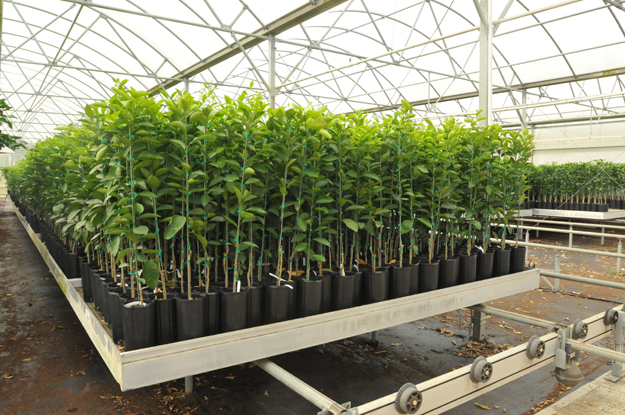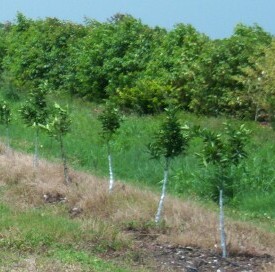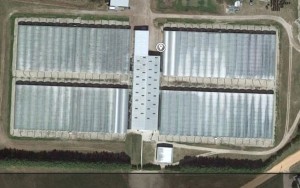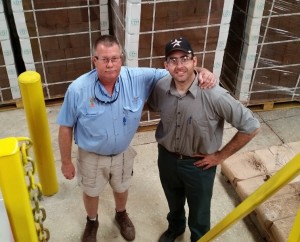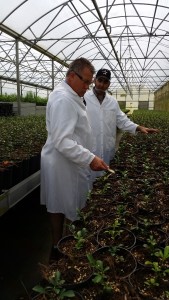In 2005 when citrus greening was discovered in orange trees in south Florida, the insidious little carrier bug, the Asian citrus psyllid, was already making its way through the state infecting and killing thousands of acres (127,000+) of citrus trees. Growers, initially paralyzed with panic, adopted a wait and see policy regarding re-planting many thousands of trees. Some nurseries, in business to supply the citrus growers with young trees, were unable to afford the uncertainty . The ones who did move forward, had some expensive adaptations to implement.
New growing mandates created in 2007 required all citrus propagators to grow new trees in greenhouses equipped with pressurized ventilation, sanitizing sprays and foot baths to prevent the start and spread of disease. This mandate would hopefully assure the health of the new young trees that would replace infected trees. Some, went above and beyond to create greenhouse systems that would not only out produce previous methods, but do so while saving labor, conserving water, using fewer chemicals and providing comfortable workplaces for employees.
Phillip Rucks, well known in the industry as an innovator and the largest citrus propagator in Florida, implemented a “hub style” series of greenhouses with four 1 acre plus houses connected to a center work area he calls “The Head.” All houses and The Head incorporate “Dutch Rolling Benches.” This is an ingenious rolling rail system incorporating waist high planting benches. Benches roll throughout all greenhouses and the center work area. All labor intensive work like grading, sizing, budding, staking, etc is performed in The Head. There, the insulated high ceiling and fan cooled work space is always comfortable. Rucks claims that even in the dead of summer, temperatures in The Head never get higher than 85 degrees.
Saving on labor costs was a strong motivation to implement the rolling rail system. The task of grading and sizing young trees is probably one of the most labor intensive duties, according to Rucks. Young trees must be monitored regularly for uniformity. Trees that don’t meet the size requirements often have been over shaded by siblings and must be pulled and placed elsewhere. Moving these to another bench with like sized trees,allows them to gain the height and get care they need. In the past this required hand loading and moving, plus hand unloading in a separate area. Now benches are simply placed side by side and the culling process can be handled efficiently without hand carrying trees from one location to another, saving an enormous amount of time and energy. Labor costs typically amount to about 70% of the cost to grow out young citrus trees to optimum transplant size. Phillip Rucks estimates that by using the Dutch Rolling Benches, he cut his labor costs by 40%.
Water conservation is also high on the list of priorities at Phillip Rucks Nursery. Sub-irrigation is used as an efficient means to provide water to the crops. AquaMat capillary irrigation mats are installed on all benches, allowing the citrus trees of tomorrow, to sip their water and nutrients as they need it, saving thousands of gallons of water. Each bench is equipped with quick disconnect fittings allowing the benches to be disconnected and reconnected as they are moved through the facility.
Each individual greenhouse is protected from human borne diseases by sanitizing sprays and foot baths. Entry to any greenhouse from the Head requires eye protection, a sterile clothing, stepping in and out of a foot bath, and turning in front of motion activated spray heads for disinfection. This keeps the possibility of spreading any kind of pathogen to a minimum.
Another Phillip Rucks innovation is using Coir as a substrate. The young citrus starts are grown in a FibreDust special “citrus” blend coir substrate. Coir is known as a superior seedling and cutting substrate that facilitates strong root systems and healthy plants. Franky De La Osa, farm manager and citrus/coir expert, began growing citrus in coir at his family’s citrus farm in Mexico before most people even knew what coir was. With his experience and love for the growing media, he knows exactly how to get results with citrus using coir fiber as a growing media.
The custom coconut coir fiber blend is re-hydrated in a large hopper by pallet load and a proprietary blend of nutrients is added to the mix. After the substrate has been blended and hydrated, it goes straight to the potting machine, traveling by conveyor. It’s no accident that the potting machine is located nearby and close to greenhouse # 1. At the potting machine, the new youngest plants are potted up from their Elle Pot birthplace. Once potted, they move to their temporary home in the first greenhouse, at kindergarten level.
Over the next 16 to 18 months a crop progresses through the greenhouses, with frequent visits to the head for various procedures like grading, budding, staking, pruning. As they approach graduation day, they will finally be moved to greenhouse #4, for their final grow out to be ready for planting in a lucky growers grove. As yet one more step in efficiency, greenhouse number 4 is conveniently located right by the shipping and loading area.
Phillip Rucks Nursery produces about a million citrus trees per year and that’s not nearly enough. Even taking into account other propagators, demand exceeds supply to the point that every tree produced in Florida is basically contract grown for specific buyers. In some ways this is a good thing for the nurseries in that they can command up to a 50 percent deposit on future product, which helps defray costs of production and reduce the risk of a grower backing out.
Even though citrus greening is still a serious threat, it seems new tools and new ways to combat the HLB disease is encouraging more growers to reset trees, expand, even invest in new groves. Funding programs like the Tree Assistance Program (TAP) are stimulating replanting with some of the smaller grove owners. This all adds up to demand for young citrus trees. While Phillip Rucks Nursery is not the only propagator, investments in productivity, equipment and growing advances are paying off at this thriving Frostproof nursery and it’s citrus will grow on in the state of Florida.

